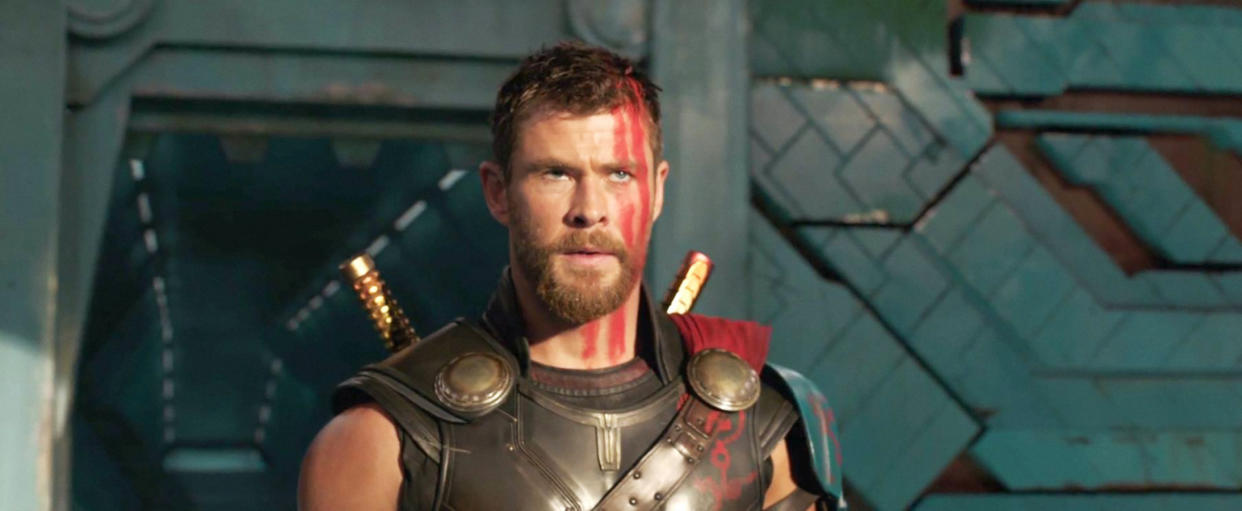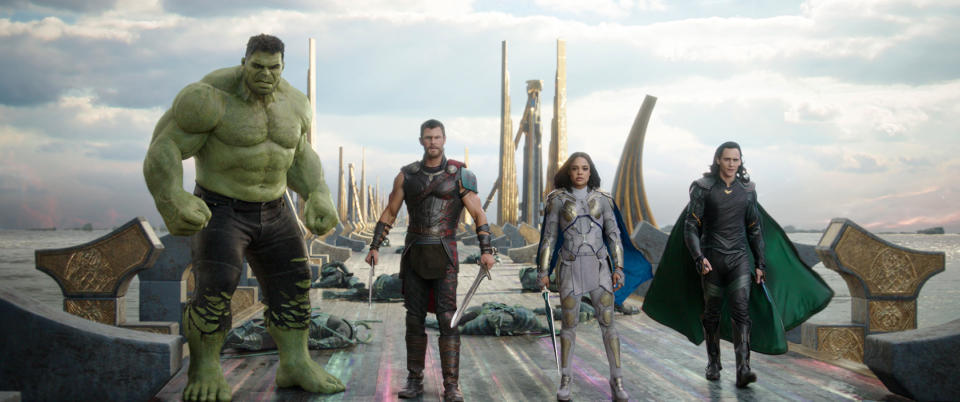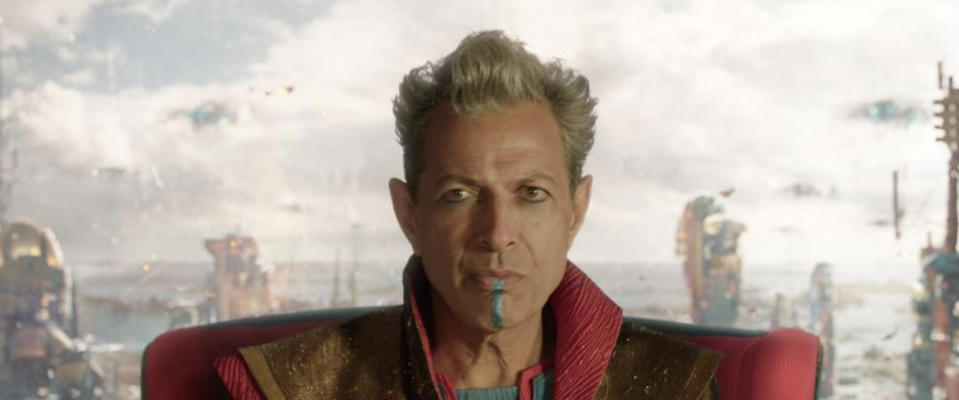'Thor: Ragnarok': Inside story on the blockbuster film's improv, cut scenes, and that rumored 90-minute run time

Earlier this year, a rumor circulated that the run time of Thor: Ragnarok would be 90 minutes, making it by far the shortest of any Marvel Cinematic Universe film. Tell that to editor Zene Baker, however, and he just laughs. As Baker explained to Yahoo Entertainment, there was never a chance that the third Thor film would clock in under two hours, no matter what director Taika Waititi claimed. But even at 130 minutes (credits and two bonus scenes included), Thor: Ragnarok zips along with humor and style. In the film, the superhero god Thor (Chris Hemsworth) must stop Hela (Cate Blanchett), the Goddess of Death, from destroying his glorious home world of Asgard in a prophesied apocalypse (the “Ragnarok” of the title). Before he can get there, the Avenger is imprisoned on a strange planet, where he is reunited with the Hulk (Mark Ruffalo) and makes unlikely allies of a warrior known as Valkyrie (Tessa Thompson), a rock creature called Korg (Waititi, in a hilarious motion-capture performance), and even his mischief-making stepbrother, Loki (Tom Hiddleston).
Before Thor: Ragnarok, a majority of Baker’s film-editing experience was in comedy, collaborating with directors like Seth Rogen and Evan Goldberg (This Is the End, The Interview) and Nick Stoller (Neighbors). Since Waititi also came from a comedy background, the two of them, along with co-editor Joel Negron, were well-equipped to bring out the absurdity in Thor’s Shakespearean saga. In a conversation with Yahoo Entertainment, Baker talked about putting together the Hulk-Thor fight, how the end-credits scenes came about, and what was left on the cutting-room floor. [Beware, there are minor spoilers below.]

Yahoo Entertainment: This is a really fun movie. I thoroughly enjoyed it.
Zene Baker: You’re welcome! [Laughs]
What was your reaction to seeing the whole thing in one piece with an actual audience?
Oh wow, it was invigorating. It was like seeing a whole brand-new movie. Because at that point, keep in mind that we’re finally seeing it with all the visual effects in place, instead of the little placeholders that we have to sometimes put in.
I’d heard a rumor that this movie was going to be 90 minutes long.
[Laughs] Yeah, Taika started that rumor.
Did he really?
Yes. He’s the one that started that rumor.
Was it ever going to be 90 minutes long?
Hell no! Ninety minutes — I don’t even know where he got 90 minutes. That’s crazy! He’ll deny this when you interview him. He’ll be like, “Oh, yeah, my intention was always 90 minutes,” in that New Zealand accent of his.
That’s very funny. It is still a little shorter, I think, than most Marvel films.
It is, yeah! I think story-wise, we’re like an hour and 54 minutes. Total run time is like 2 hours 10 minutes. But keep in mind there’s a lot of people who worked on the film, so there’s a lot of credits. And tags. You can’t forget about the tags.
How far in advance did Taika know what the tags were going to be?
There’s one tag we knew pretty early on, and then another tag was like, “We should try this as a tag.” And that was fairly late in the process.
Was that the Jeff Goldblum one?
I’ll let your imagination run wild.

What kind of stuff had to be taken out to get that run time?
There was a heavy amount of plot and humor. So there were some plot points and some little character things that, for the sake of telling a very streamlined and entertaining story, we figured were better left out, honestly. There were maybe a couple of things explaining Val’s character a little further that we left out. [Tessa Thompson has confirmed that there was more a flashback post-battle scene that suggested she had a female partner.] Some extra things with Korg that, while they were really hilarious, in the greater context of the movie, they started to feel extraneous. And we had to ask ourselves tough questions like, “Do we need it? Nah, we don’t need it, let’s lose it and see how it plays.” And it played better.

That’s a tough job.
It’s very tough. Thankfully, Taika, Joel Negron, the other editor, and myself — we’re not precious about the extraneous stuff. Even though it’s hard, we all seemed to be on the wavelength of, “What’s going to tell a better story?”
It’s a very funny movie. Were actors encouraged to improvise on some takes?
This is my first Marvel movie, so if I had to guess, this one had more improv in the shooting than most other Marvel movies. I’m definitely from a very heavy comedy-improv background for editing, so even though this had a lot of improv, it was still much farther left than what I was typically used to, with, you know, Seth Rogen, Evan Goldberg as directors, and Nick Stoller for the Neighbors movies. So we all get in there and we all assemble the stuff. We’re trying to put as much in front of Taika as we can without veering too far into a tangent and away from story, but we still want to try to showcase the funnier bits of the improv, because [of] always a golden moment that might surprise everybody. So that’s kind of the idea. And then it’s just workshopping the material further down and further down.
Were there other ways in which doing Thor: Ragnarok was different than doing the comedies you’re better known for?
[Laughs] Definitely. The biggest change, obviously, is just the sheer immense size of a Marvel project. It’s just a really giant machine. You’ve got a lot of voices in the room. And actually you’re very thankful that the voices in the room are crazy smart. So in some ways it’s challenging due to the amount of voices, but in other ways it’s really streamlined and efficient. I was delighted and surprised at the same time.
I’d love to know what it was like putting together the Hulk-Thor coliseum fight. I assume you didn’t have the final Hulk for at least some of the process, right?
True. There are tricks that we’re able to use. Thankfully we live in an age of pre-visualization, so it’s an incredible tool set. Hopefully I’m not dispelling any myths or anything! The Hulk-Thor fight, thankfully, a lot of it was pre-visualized with moving images, with little representations of Thor and Hulk and so forth. It gives you a blueprint to follow, both when shooting and when initially assembling the scene. And then when you start, I call it filling in the gaps, with real footage, you’re making new discoveries as far as, “OK, well, he moves faster, he moves slower, he’s got a good joke here so let’s accentuate that joke.” It’s a giant sequence, and definitely Joel and Taika and myself were kind of very much going through that.
Watch: Mark Ruffalo on how he gave voice, and body, to Hulk in ‘Ragnarok’:
How do you approach balancing the action and effects stuff with the humor?
I’ll give a lot of credit to Taika for setting this very humorous tone through the shooting. It was a very light type of thing, and very easygoing. I think being able to set that tone is instrumental, and it trickles down very much into the footage you’re going to get, so it kind of makes it easy. And blending humor with some action — this sounds dumb, it sounds like I’m bragging, but it’s always come easily for me. It just kind of works. I’ve always liked that sort of humor blended with action, so I was just very fortunate to be able to exercise that part on this movie.
This might sound like a very uneducated question in terms of what you do, but when you’re dealing with these effects shots that must cost so much money and require so many people to build, do you feel pressure to use more of those shots?
Not to give too many trade secrets away, but because of the amount of people who work on each shot, you do have to sort of prioritize sequences, just to kind of keep the schedule going in a way that you’ll be able to complete everything. So [we] have to kind of jump around to, “All right, this sequence is going to need the most work, so let’s try to workshop this one pretty early on.” And thankfully Marvel has resources in that, if for some reason we need to go back and tweak a sequence, we’re able to do that. But yeah, you do sort of have to follow a priority list: This is going to take the most resources, the most people in order for a digital-effects artist to render and complete and really bring something to it, so you want to get those sequences out as fast as you can within reason to be able to tell the best story that you can. That sounds like a very rote answer, but it’s actually true.
Before Thor: Ragnarok, you edited another demon-destroying-the-world film, This Is the End. How would you compare those two apocalypse sequences?
One is very, very R-rated, and one is very, very not R-rated.
Thor: Ragnarok is now playing in theaters.
Watch: Director Taika Waititi reveals origin of shirtless Chris Hemsworth scene in ‘Thor: Ragnarok’:
Read more from Yahoo Entertainment:
‘Thor: Ragnarok’: Your ultimate guide to Easter eggs, callbacks, and in-jokes
Mark Ruffalo explains how he gave voice, and action, to the Hulk in ‘Thor: Ragnarok’
‘Thor: Ragnarok’: Jaimie Alexander explains why Lady Sif is MIA
Throwback Thor’s day: Let’s revisit the first live-action battle between Hulk and Thor


